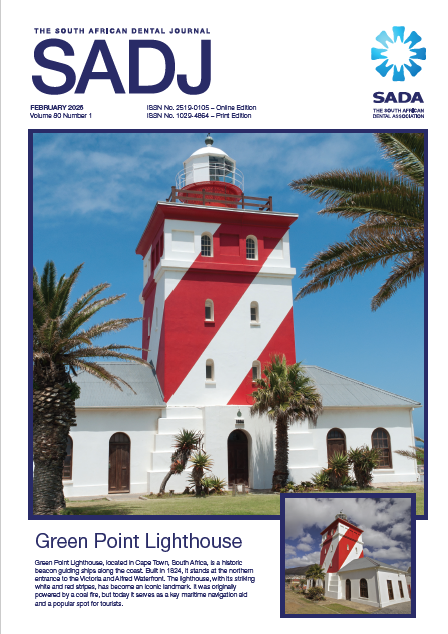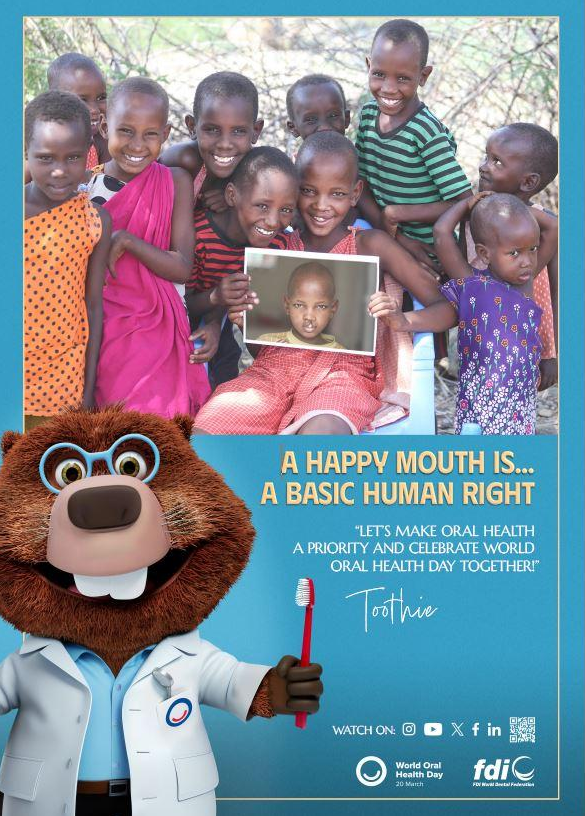A comparison of the flexibility and fracture point of cast cobalt-chromium, milled cobalt-chromium, laser printed cobalt-chromium and milled Polyetherketoneketone partial denture clasps
DOI:
https://doi.org/10.17159/sadj.v80i01.20361Keywords:
Chemical resistance, Mechanical strength, CrCo (Cobalt-chromium), PEKK (Polyetherketoneketone)Abstract
Removable partial dentures (RPD) are a cost-effective way of replacing missing teeth. Acrylic RPDs can be used successfully, but those with metal frameworks are superior due to their increased strength, durability, retention, fit, longevity and decreased soft tissue coverage. Cast cobalt-chromium (CrCo) metal alloys have traditionally been used in RPDs, but have shortcomings. Metal may increase the weight and is inflexible, making it unsuitable for clasps on small teeth or those with deep undercuts. The casting process can result in unpredictable internal porosity, which can cause irreparable fracturing of the clasps. Furthermore, metal clasps in the aesthetic zone are unsightly. Polyetherketoneketone (PEKK) is a new-generation thermoplastic used in orthopaedic surgery to manufacture prosthetic components due to its desirable physical properties, ease of manufacture and tissue biocompatibility. It may also have possible dental
applications if used with computer-aided design (CAD) and computer-aided manufacturing (CAM) processes to make RDP frameworks. Other advantages include good chemical resistance, desirable mechanical strength and flexibility, excellent abrasion resistance, flame resistance, antibacterial properties, and no backscatter, shadows or artefacts during conventional X-ray imaging or radiotherapy. It has flexibility and elasticity comparable to cortical bone, is lightweight and may be used in 3D imaging, printing and milling processes
Downloads
References
1. Carr AB, Brown DT. McCracken’s removable partial prosthodontics-e-book. Elsevier Health Sciences; 2010 Jun 22.
2. Behr M, Zeman F, Passauer T, Koller M, Hahnel S, Buergers R, Lang R, Handel G, Kolbeck C. Clinical performance of cast clasp-retained removable partial dentures: a retrospective study. Int J Prosthodont. 2012 Mar 1;25(2).
3. Campbell SD, Cooper L, Craddock H, Hyde TP, Nattress B, Pavitt SH, Seymour DW. Removable partial dentures: The clinical need for innovation. J Prosthet Dent. 2017 Sep 1;118(3):273-80.
4. Applegate OC. Essentials of Removable Partial Denture Prosthesis. 3rd ed. Philadelphia: WB Saunders Co.; 1966. p. 185-229.
5. Dunham D, Brudvik JS, Morris WJ, Plummer KD, Cameron SM. A clinical investigation of the fit of removable partial dental prosthesis clasp assemblies. J Prosthet Dent. 2006;95:323-6.
6. Al Jabbari YS. Physico-mechanical properties and prosthodontic applications of Co-Cr dental alloys: a literature review. J Adv Prosthodont. 2014 Apr 1;6(2):138-45.
7. Bates JF. Studies related to the fracture of partial dentures; Flexural fatigue of a cobalt-chromium alloy. Br Dent J. 1965;118:532-7.
8. Van Noort R, Lamb DJ. A scanning electron microscope study of Co-Cr partial dentures fractured in service. J Dent. 1984;12:122-6.
9. Dharmar S, Rathnasamy RJ, Swaminathan TN. Radiographic and metallographic evaluation of porosity defects and grain structure of cast chromium cobalt removable partial dentures. J Prosthet Dent. 1993;69:369-73.
10. Marxkors R, editor. The partial denture with metal framework. Germany: BEGO Bremer Goldschl garei Wilhelm Herbst; 1984.
11. Vermeulen AH, Keltjens HM, van’t Hof MA, Kayser AF. Ten-year evaluation of removable partial dentures: survival rates based on retreatment, not wearing and replacement. J Prosthet Dent. 1996;76:267-72.
12. Van Noort R. The future of dental devices is digital. Dent Mater. 2012;28:3-12.
13. Pereira AL, de Medeiros AK, de Sousa Santos K, de Almeida ÉO, Barbosa GA, Carreiro AD. Accuracy of CAD-CAM systems for removable partial denture framework fabrication: A systematic review. J Prosthet Dent. 2021 Feb 1;125(2):241-8.
14. Takaichi A, Fueki K, Murakami N, Ueno T, Inamochi Y, Wada J, Arai Y, Wakabayashi N. A systematic review of digital removable partial dentures. Part II: CAD/CAM framework, artificial teeth, and denture base. J Prosthodontic Res. 2022;66(1):53-67.
15. Tasaka A, Kato Y, Odaka K, Matsunaga S, Goto TK, Abe S, Yamashita S. Accuracy of Clasps Fabricated with Three Different CAD/CAM Technologies: Casting, Milling, and Selective Laser Sintering. Int J Prosthodont. 2019 Nov 1;32(6):526-9.
16. Tannous F, Steiner M, Shahin R, Kern M. Retentive forces and fatigue resistance of thermoplastic resin clasps. Dent Mater. 2012 Mar 1;28(3):273-8.
17. Campbell SD, Cooper L, Craddock H, Hyde TP, Nattress B, Pavitt SH, Seymour DW. Removable partial dentures: The clinical need for innovation. J Prosthet Dent. 2017 Sep 1;118(3):273-80.
18. Frank RP, Nicholls JI. A study of the flexibility of wrought wire clasps. J Prosthet Dent. 1981 Mar 1;45(3):259-67.
19. Sykes LM, Dullabh HD, Chandler HD, Bunn B, Essop AR. Flexibility of technopolymer clasps compared with cobalt-chromium and titanium clasps. SADJ. 2015;80(1):22-7.
20. Yamazaki T, Murakami N, Suzuki S, Handa K, Yatabe M, Takahashi H, Wakabayashi N. Influence of block-out on retentive force of thermoplastic resin clasps: an in vitro experimental and finite element analysis. J Prosthodontic Res. 2019;63(3):303-8.
21. Torii M, Nakata T, Takahashi K, Kawamura N, Shimpo H, Ohkubo C. Fitness and retentive force of cobalt-chromium alloy clasps fabricated with repeated laser sintering and milling. J Prosthodontic Res. 2018 Jul 1;62(3):342-6.
22. Al Jabbari YS. Physico-mechanical properties and prosthodontic applications of Co-Cr dental alloys: a review of the literature. J Adv Prosthodont. 2014 Apr 1;6(2):138-45.
23. Adam I, Dzogbewu TC, Combrinck J, du Preez W. Laser Powder Bed Fusion of Co-Cr: A Material Comparison. In: MATEC Web of Conferences. 2022;370:11002.
24. Sadek SA, Dehis WM, Hassan H. Comparative study clarifying the most suitable material to be used as partial denture clasps. Open Access Maced J Med Sci. 2018 Jun 6;6(6):1111-5.
Downloads
Published
Issue
Section
License

This work is licensed under a Creative Commons Attribution-NonCommercial 4.0 International License.





.png)